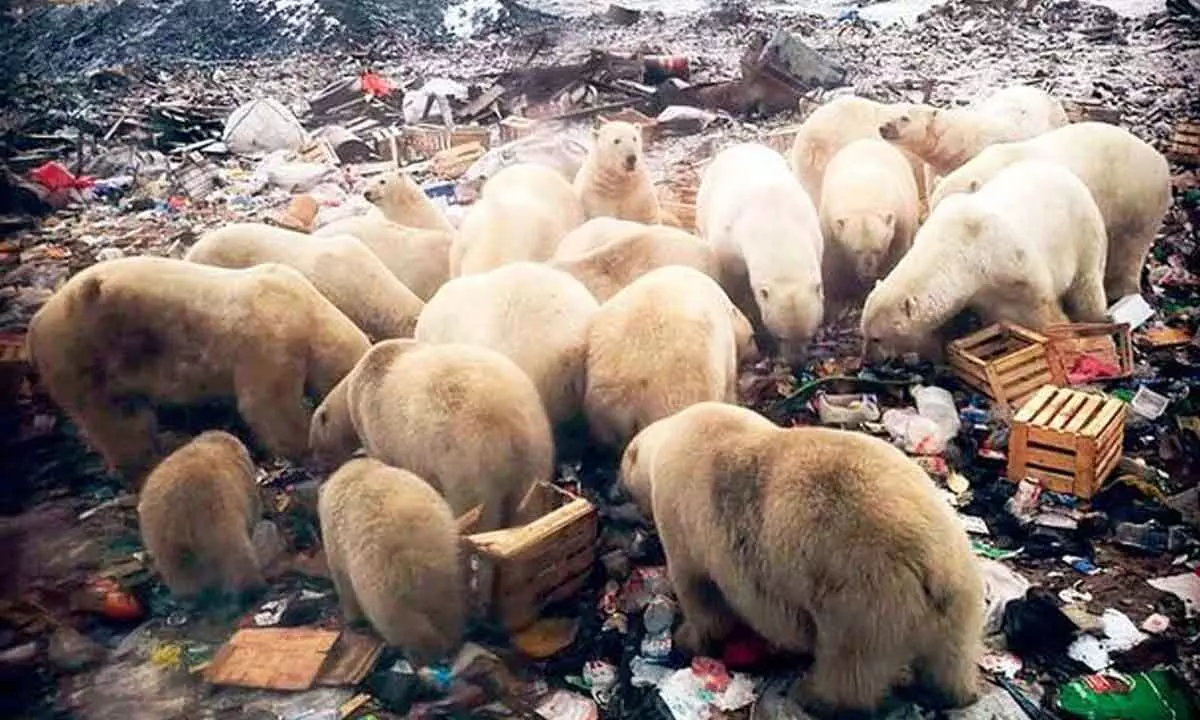Live
- Demolition of illegal buildings in Whitefield amid public scepticism
- TCS recruits 52 PB Siddhartha students
- Mcap plunges by Rs 2.19 L cr
- Kenya cancels airport, energy deals
- Plans underway for green ammonia plant in Kakinada
- TG may review MoUs with Adani
- Lokayukta conducts raids on Mines and Geology Officer
- Minister Durgesh urged not to impose entry fees on tourists at beaches
- Naxal Resettlement and Surrender Committee to visit Vikram Gowda encounter site
- 10 yrs of BRS ‘misrule’ Vs 10 mths of people’s govt
Just In
Garbage making life harder for polar bears


These invasions have been steadily increasing in Arctic settlements, though this case, in the winter of 2019, was one of the worst.
These invasions have been steadily increasing in Arctic settlements, though this case, in the winter of 2019, was one of the worst. While few people have been attacked, the number of dead bears has climbed. I'm a biologist who has studied bears for the past 30 years. Over millennia, polar bears evolved an ability to locate food in the harsh Arctic climate. Now, as climate change causes a loss of sea ice, their foraging season is shorter and they're forced onto land far more than ever before. Once on land, bears' noses draw them into villages where they find ample unsecured food.
My colleagues and I recently published a paper on how human food and waste are becoming a major threat to polar bear existence – and jeopardize human safety. We also offer solutions. Masters of scent and memory Polar bears live in an extremely austere environment where finding food drives their every move. To aid them in their perpetual hunt for food, polar bears have one of the most highly developed senses of smell of any animal on the planet. Their ability to detect scents from afar can be a problem, however, when the scent is not coming from seals – their main food resource.
Climate change has caused an alarming decrease in polar sea ice. Approximately 40% less ice exists today than only three decades ago. Not only does less sea ice cover the Arctic Ocean, but what remains is not as thick as it used to be – a prelude to what will eventually become an ice-free Arctic basin. When that happens, all polar bears will be forced ashore, without the ability to hunt seals. Polar bears' cruising the shores and entering human settlements are direct results of reduced sea ice – and the loss of hunting opportunities that come with it.
The threat of unsecured garbage Indigenous peoples and more recent arrivals make up the nearly 4 million people living throughout the Arctic in the countries of Russia, Norway, Greenland, Canada and the U.S. The economies of these villages are largely subsistence-based and are by no means affluent. Historically, food was never discarded in these areas.
Today's throwaway global economy has resulted in dumps full of waste, including foodstuffs. When polar bears enter these dumps in search of food, they are attracted to strong-smelling substances, some of which are not even edible. For example, antifreeze attracts bears – and is fatal when ingested. The many chemicals in dumps become toxic potions, which either kill bears outright or weaken their immune systems.
Additionally, bears have been known to ingest nonfoods. Wood, plastics and metal have all been found in dead bears' stomachs. Wraps, bags and other membranelike items jam up the small opening from the bear's stomach to its intestine, resulting in a slow and painful death. Once bears have thoroughly rummaged through dumps, they spin off into nearby villages – confronting people, attacking their pets and livestock and foraging around structures, within which they expect to find food.
Solutions already exist to remedy this situation. However, they require money and political will.

© 2024 Hyderabad Media House Limited/The Hans India. All rights reserved. Powered by hocalwire.com






